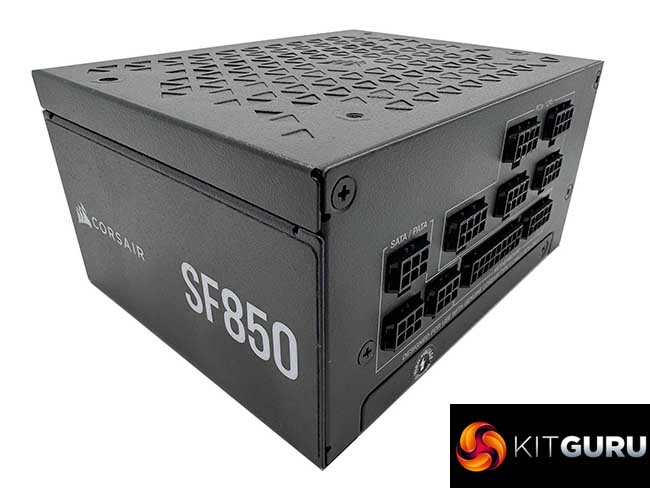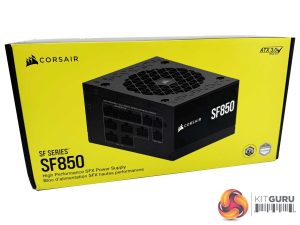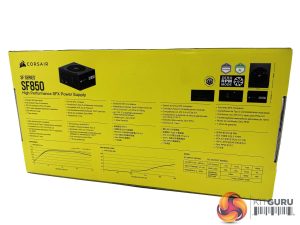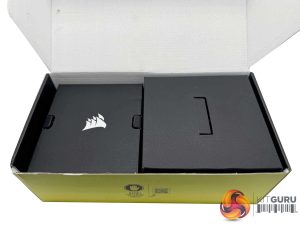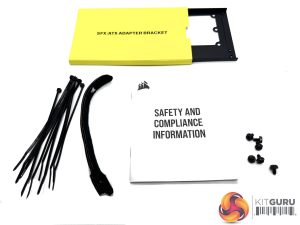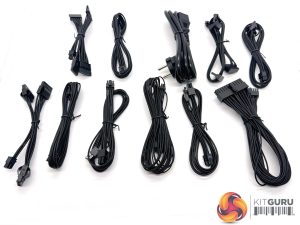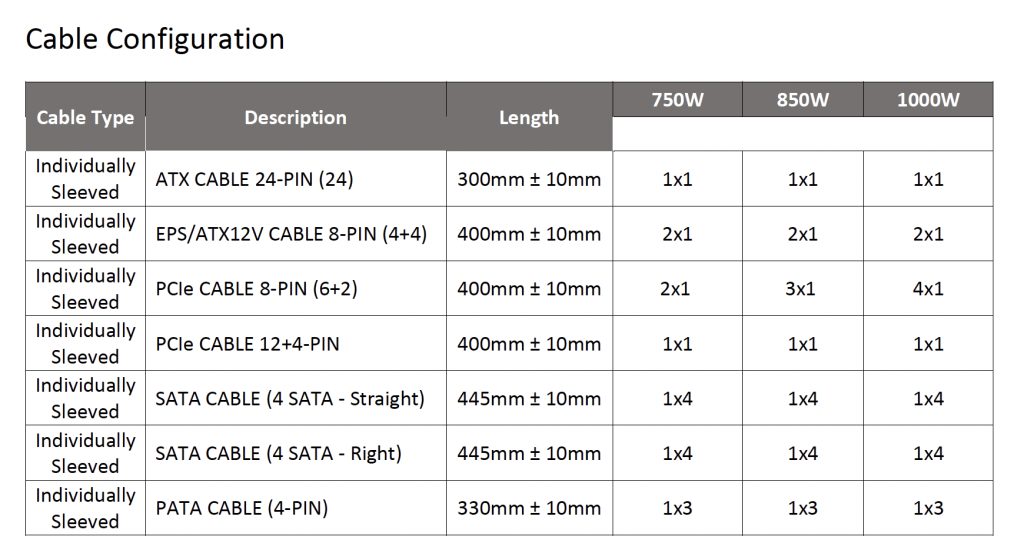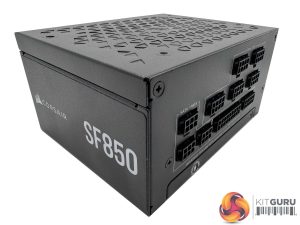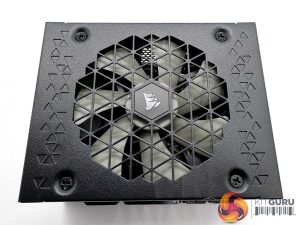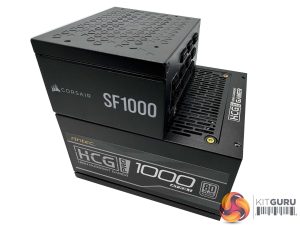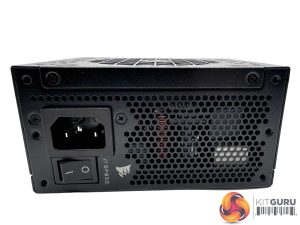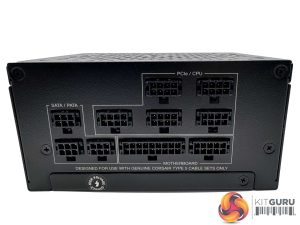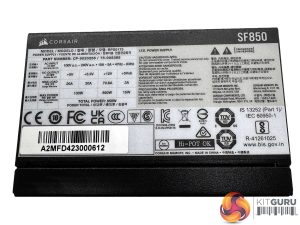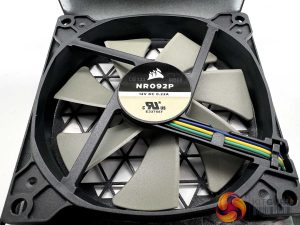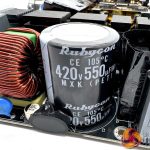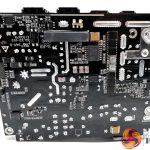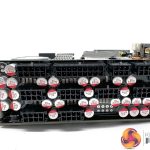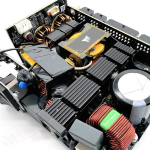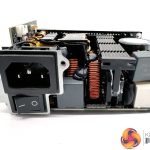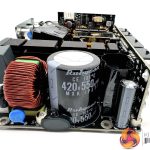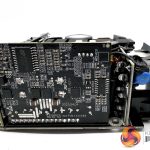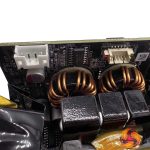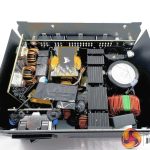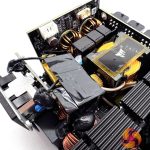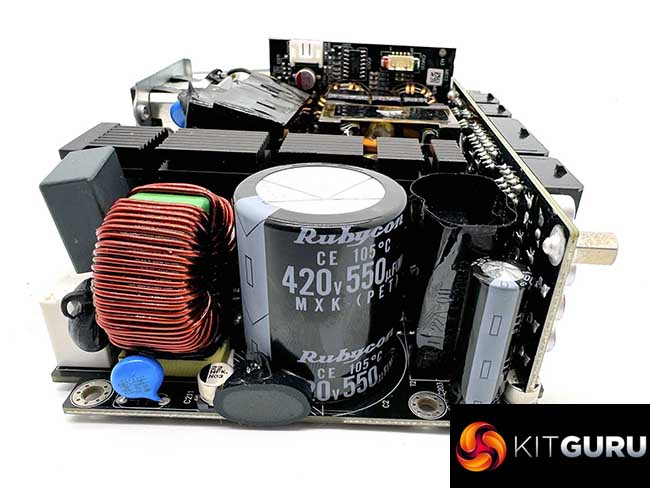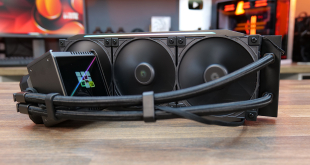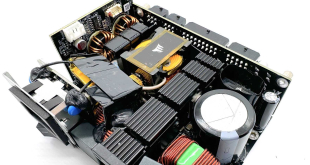
Following on from our recent review of the Corsair SF1000 Platinum power supply, today we look at its smaller sibling – the SF850. This is another new ATX 3.1, fully modular SFX design measuring a diminutive 100 x 125mm x 63.5mm, with a full 7 year warranty. Today we will find out if it is as good as the higher capacity 1000 Watt unit that walked away with our highest award.
Corsair experienced great success with their previous SF L range of power supplies. For these new versions they have improved efficiency levels while make sure the power supply is smaller to fit into even more restrictive chassis designs.
- Cybenetics Platinum Rated SFX Power: Massive Platinum-rated power in a compact SFX form-factor, perfect for the most power-dense small-form-factor PCs or saving space in larger cases.
- ATX 3.1 Compliant & PCIe 5.1 Ready: Compliant with the ATX 3.1 power standard from Intel®, supporting the PCIe Gen 5 platform and resisting transient power spikes.
- Fully Modular, Type-5 Micro-Fit PSU Connectors: With flexible cabling, taking up less space for tidy cable management and compatibility in small cases.
- 92mm PWM Cooling Fan: Delivers powerful cooling with low-noise operation thanks to a fluid dynamic bearing.
- 105°C Rated Japanese Capacitors: For unwavering power and reliability. 6. Zero RPM Mode: The fan stays off until it’s needed, for near-silent operation at low and medium loads.
- 50°C Continuous Operating Temperature: For reliable power even under high-stress conditions.
- SFX-to-ATX Bracket Included: Enables installation into ATX cases for more cable space in larger systems.
- Seven-Year Warranty: For complete peace of mind.
The box artwork is identical to the SF1000 – except for the image – showing SF850 on the side of the chassis. As mentioned previously, this power supply achieves the Cybenetics Platinum rating which, in 2024, is worth a lot more than the traditional 80 Plus ratings.
The rear of the box is highlighting key features as well as some informational graphs on noise levels and efficiency.
Inside the box, are two compartments – one containing the cables and accessories with the power supply sandwiched between two foam slabs for shipping protection.
Corsair include literature on the product, along with cable ties, mounting screws and an ATX adapter bracket (if needed).
The modular cables are all very high quality, individual sleeved – meaning they look great.
The cables are long enough for usage in smaller chassis.
The Corsair SF850 is a tiny power supply measuring only 125mm x 100mm x 63.5mm (WxHxD). The finishing quality is high and neutral by colour with some silver white accenting on the lettering. The unit weighs around 0.965kg.
The fan is hidden behind a grille at the top. We will take a closer look at the fan when we open the unit shortly.
To give you an idea of just how small these units are – you can see the 1000W model above, resting on the Antec HCG1000 unit we reviewed recently .
One side of the power supply is home to the power connector and switch, alongside a vented panel to aid with airflow.
The other side houses the modular bay, split into three rows and labelled for ease of use during the install phase.
The power sticker shows that this unit can deliver 70.8A via the +12 rail (down from 83.3A on the 1000W unit). The minor +3.3V and +5V rails can deliver 20A. Corsair have removed the -12V rail from this power supply to increase efficiency and to remove some costs. Technically there really is no need for this anyway in 2024.
Corsair are using the NR092P fan, which is the same fan they are using in the 1000W version of this supply. It is rated 12V 0.22A. As we said before this is a high quality FDB (Fluid Dynamic Bearing) fan which we have seen in the past on a semi-regular basis. There are no plastic strips on the fan to direct airflow to specific parts of the PSU underneath.
This unit is a Great Wall OEM part, like some previous Corsair designs. The PCB is tiny, as you can see in the images above, and very densely packed. The build quality looks very good to me and soldering quality on the PCB is excellent.
It is a half bridge topology design and an LLC resonant converter increases the efficiency levels via lossless switching. On the secondary side a synchronous rectification adopts six FETs to regulate the 12V rail. As usual, the minor rails are generation via a pair of DC-DC converters via a PWM controller.
The primary stage capacitor is a 105c Rated Rubycon rated at 420V 550uF (the SF1000 has a 740uF primary cap). These are quality Japanese capacitors we value highly, alongside others such as Nippon Chemi Con and Nichicon. The power supply offers OCP, OVP, SCP, OPP and OTP protections.
Correctly testing power supplies is a complex procedure and KitGuru have configured a test bench which can deliver up to a 2,000 watt DC load. We run at 35c in our environment to greater reflect warmer internal chassis conditions.
We use combinations of the following hardware:
• SunMoon SM-268
• CSI3710A Programmable DC load (+3.3V and +5V outputs)
• CSI3711A Programmable DC load (+12V1, +12V2, +12V3, and +12V4)
• Extech Power Analyzer
• Extech MultiMaster MM570 digital multimeter
• Extech digital sound level meter
• Digital oscilloscope (20M S/s with 12 Bit ADC)
• Variable Autotransformer, 1.4 KVA
We test in a single +12V configuration.
|
DC Output Load Regulation
|
||||||||||
|
Combined DC Load |
+3.3V
|
+5V
|
+12V
|
+5VSB
|
-12V | |||||
|
A
|
V
|
A
|
V
|
A
|
V
|
A
|
V
|
A | V | |
|
85W
|
0.95
|
3.33
|
0.92
|
5.01
|
6.00
|
12.05
|
0.50
|
5.01
|
0.20 | -12.01 |
|
170W
|
1.70
|
3.33
|
1.67
|
5.01
|
12.35
|
12.05
|
1.00
|
5.01
|
0.20 | -12.01 |
|
425W
|
3.00
|
3.33
|
3.05
|
5.01
|
32.20
|
12.04
|
1.50
|
5.01
|
0.30 | -12.01 |
| 640W | 4.05 | 3.33 | 4.05 | 5.01 | 49.00 | 12.03 | 2.00 | 5.01 | 0.30 | -12.01 |
|
850W
|
5.00
|
3.33
|
5.23
|
5.01
|
65.52
|
12.02
|
2.50
|
5.01
|
0.50 | -12.01 |
Load regulation is tight on 12V.
| Corsair SF850 Platinum | Maximum Load |
| 1002W |
We managed to get the power supply to deliver 1002W before it would shut down, delivering around 150W more than rated specifications.
Next we want to try Cross Loading . This basically means loads which are not balanced. If a PC for instance needs 500W on the +12V outputs but something like 30W via the combined 3.3V and +5V outputs then the voltage regulation can fluctuate badly.
| Cross Load Testing | +3.3V | +5V | +12V | -12V | +5VSB | |||||
| A | V | A | V | A | V | A | V | A | V | |
| 760W | 1.0 | 3.33 | 1.0 | 5.03 | 60.0 | 12.02 | 0.2 | -12.01 | 0.50 | 5.01 |
| 165W | 15.0 | 3.32 | 18.0 | 5.01 | 2.0 | 12.04 | 0.2 | -12.01 | 0.50 | 5.01 |
The power supply dealt with the demanding cross load test without any major concerns.
We then used an oscilloscope to measure AC ripple and noise present on the DC outputs. We set the oscilloscope time base to check for AC ripple at both high and low ends of the spectrum.
ATX12V V2.2 specification for DC output ripple and noise is defined in the ATX 12V power supply design guide.
|
ATX12V Ver 2.2 Noise/Ripple Tolerance
|
|
|
Output
|
Ripple (mV p-p)
|
|
+3.3V
|
50
|
|
+5V
|
50
|
|
+12V1
|
120
|
|
+12V2
|
120
|
|
-12V
|
120
|
|
+5VSB
|
50
|
Obviously when measuring AC noise and ripple on the DC outputs the cleaner (less recorded) means we have a better end result. We measured this AC signal amplitude to see how closely the unit complied with the ATX standard.
| AC Ripple (mV p-p) | ||||
| DC Load | +3.3V | +5V | +12V | 5VSB |
| 100W | 15 | 15 | 19 | 10 |
| 225W | 16 | 18 | 23 | 12 |
| 450W | 17 | 19 | 27 | 14 |
| 675W | 18 | 20 | 31 | 17 |
| 850W | 22 | 23 | 36 | 20 |
Noise suppression is good across +3.3V, +5V and +12V rails. All of these are well within industry rated parameters.
|
Efficiency (%) 240V
|
|
|
100W
|
89.6
|
|
225W
|
92.7
|
|
450W
|
94.2
|
|
675W
|
92.8
|
| 850W | 90.1 |
The efficiency results are really good, achieving Platinum rated efficiency levels, peaking at just over 94% between 45-55% load, and dropping to around 90% at full load.
We take the issue of noise very seriously at KitGuru and this is why we have built a special home brew system as a reference point when we test noise levels of various components. Why do this? Well this means we can eliminate secondary noise pollution in the test room and concentrate on components we are testing. It also brings us slightly closer to industry standards, such as DIN 45635.
Today to test the power supply we have taken it into our acoustics room environment and have set our Digital Sound Level Noise Decibel Meter Style 2 one meter away from the unit. We have no other fans running so we can effectively measure just the noise from the unit itself.
As this can be a little confusing for people, here are various dBa ratings in with real world situations to help describe the various levels.
KitGuru noise guide
10dBA
– Normal Breathing/Rustling Leaves
20-25dBA
– Whisper
30dBA
– High Quality Computer fan
40dBA
– A Bubbling Brook, or a Refrigerator
50dBA
– Normal Conversation
60dBA
– Laughter
70dBA
– Vacuum Cleaner or Hairdryer
80dBA
– City Traffic or a Garbage Disposal
90dBA
– Motorcycle or Lawnmower
100dBA
– MP3 Player at maximum output
110dBA
– Orchestra
120dBA
– Front row rock concert/Jet Engine
130dBA
– Threshold of Pain
140dBA
– Military Jet takeoff/Gunshot (close range)
160dBA
– Instant Perforation of eardrum
|
Noise (dBA)
|
|
|
100W
|
<28.0
|
|
225W
|
31.4
|
|
450W
|
33.6
|
|
675W
|
36.5
|
| 850W | 37.4 |
The high quality FDB fan is not very noticeable until load hits around 600 Watts demand – then you can hear it ramping up. It is a pretty small fan, so usually noise levels are inherently higher. It's not the quietest unit we have tested, but I would not call noise levels excessive either. Such a small physical footprint always comes with some trade off.
|
Temperature (c)
|
||
|
Intake
|
Exhaust
|
|
|
100W
|
37
|
41
|
|
225W
|
38
|
46
|
|
450W
|
40
|
51
|
|
675W
|
45
|
58
|
|
850W
|
46
|
61
|
The large fan and high levels of efficiency ensure good airflow across the components and good operating temperatures.
|
Maximum load
|
Efficiency
|
|
1002 watts
|
89.1
|
At 1002 Watts, this unit managed to deliver efficiency at 89.1%.
After reviewing the Corsair SF1000 around a week ago (review HERE ) I had high expectations for the SF850 and it is fair to say I have not been disappointed. These new SF Platinum-rated units are class leading in the SFX market – the partnership with Great Wall is proving such a success for Corsair in 2024.
Like its bigger brother, the SF850 produces great results across a variety of tests, with only ripple suppression not hitting the heights that some other designs achieve. This is not a concern, as discussed before, as they are still very good results, just not exceptional .
Load regulation scores highly in our tests, and the unit achieved 80 Plus Platinum levels which is impressive considering the diminutive form factor. More importantly, the unit also achieves Platinum approval from Cybenetics and really everyone should really be paying more attention to this verification platform in 2024. 80 Plus ratings are somewhat dated and can sometimes be fooled, making them much less useful in the real world.
This is not the quietest power supply you can buy, however this is always going to be a trade off with a small physical unit incorporating a 92mm fan, rather than 120mm or 135mm equivalent. A smaller fan at any given speed – if quality is consistent between the models – will always generate slightly more noise than a larger fan. It is unavoidable.
Right now you can pick up the SF850 power supply from SCAN in the UK for £174.98 HERE (the larger capacity SF1000 is available for £199.99 HERE .) I consider both good value purchase as it targets a market which often gets overlooked by other brands.
Discuss on our Facebook page HERE .
Pros:
- High quality design from soldering to components.
- 105C Japanese capacitors.
- Stellar build quality.
- Tight load regulation.
- FDB fan is great.
- 7 year warranty.
- Compact design suits many builds.
- Quality cabling.
- Fully modular.
- ATX 3.1/PCIe 5.1.
- SFX to ATX adapter bracket in box.
Cons:
- Not the quietest power supply under load.
KitGuru says: The SF850 Platinum is another fantastic power supply from Corsair – just as good at its bigger brother. It delivers high quality power and super efficiency combined with stellar build quality. It earns our highest MUST HAVE award today.
 KitGuru KitGuru.net – Tech News | Hardware News | Hardware Reviews | IOS | Mobile | Gaming | Graphics Cards
KitGuru KitGuru.net – Tech News | Hardware News | Hardware Reviews | IOS | Mobile | Gaming | Graphics Cards


